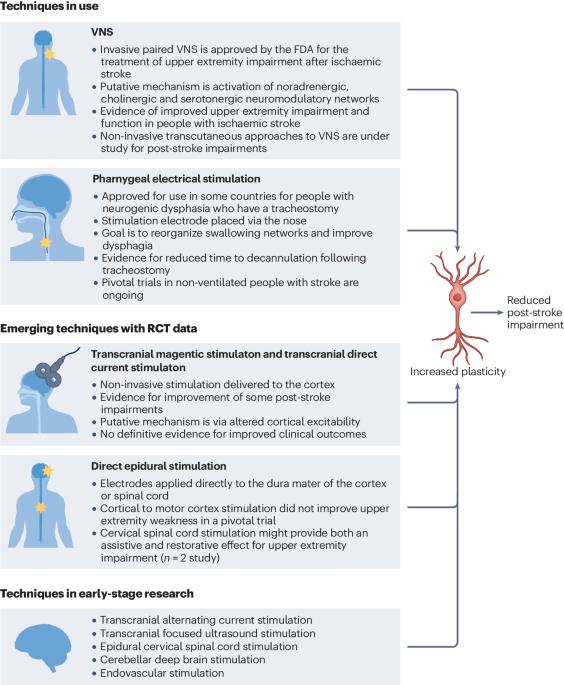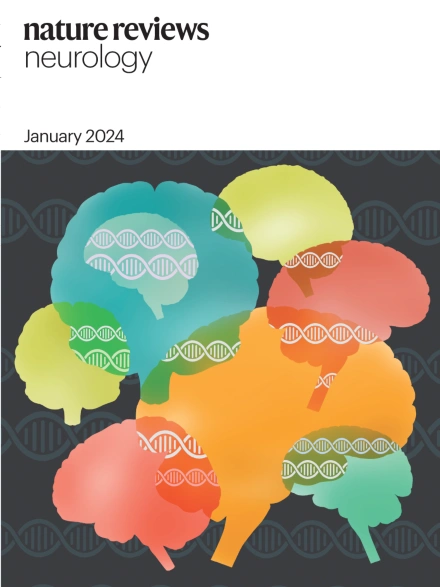神经刺激治疗中风后遗症
IF 28.2
1区 医学
Q1 CLINICAL NEUROLOGY
引用次数: 0
摘要
神经刺激是利用电刺激来调节神经系统的活动,目前常用于治疗慢性疼痛、运动障碍和癫痫。目前,许多神经刺激技术已显示出治疗中风患者肢体障碍的前景。2021 年,美国食品及药物管理局批准迷走神经刺激作为强化康复治疗的辅助手段,用于治疗缺血性中风后的慢性上肢功能障碍。2024 年,英国国家健康与护理卓越研究所有条件地批准了咽部电刺激疗法,用于治疗气管切开的中风患者的神经源性吞咽困难。许多其他方法也在关键设备试验中进行了测试,还有一些方法正在进行早期研究。通常情况下,神经刺激技术旨在增强神经可塑性,以应对训练和康复,但其作用机制各不相同,尚未完全明了。神经刺激技术在脑卒中后的应用中具有许多实际优势,如剂量和时间的精确性,但其实施可能具有侵入性且成本高昂。本综述重点介绍目前已投入临床使用或已进入关键试验阶段的神经刺激技术,这些技术在治疗中风后损伤方面显示出巨大的前景。本文章由计算机程序翻译,如有差异,请以英文原文为准。

Neurostimulation for treatment of post-stroke impairments
Neurostimulation, the use of electrical stimulation to modulate the activity of the nervous system, is now commonly used for the treatment of chronic pain, movement disorders and epilepsy. Many neurostimulation techniques have now shown promise for the treatment of physical impairments in people with stroke. In 2021, vagus nerve stimulation was approved by the FDA as an adjunct to intensive rehabilitation therapy for the treatment of chronic upper extremity deficits after ischaemic stroke. In 2024, pharyngeal electrical stimulation was conditionally approved by the UK National Institute for Health and Care Excellence for neurogenic dysphagia in people with stroke who have a tracheostomy. Many other approaches have also been tested in pivotal device trials and a number of approaches are in early-phase study. Typically, neurostimulation techniques aim to increase neuroplasticity in response to training and rehabilitation, although the putative mechanisms of action differ and are not fully understood. Neurostimulation techniques offer a number of practical advantages for use after stroke, such as precise dosing and timing, but can be invasive and costly to implement. This Review focuses on neurostimulation techniques that are now in clinical use or that have reached the stage of pivotal trials and show considerable promise for the treatment of post-stroke impairments. Various neurostimulation techniques are being explored for the treatment of physical impairments in people with stroke. This Review summarizes our current knowledge of the techniques that are now in clinical use or have reached the stage of pivotal trials alongside emerging techniques and highlights the need for further studies.
求助全文
通过发布文献求助,成功后即可免费获取论文全文。
去求助
来源期刊

Nature Reviews Neurology
医学-临床神经学
CiteScore
29.90
自引率
0.80%
发文量
138
审稿时长
6-12 weeks
期刊介绍:
Nature Reviews Neurology aims to be the premier source of reviews and commentaries for the scientific and clinical communities we serve. We want to provide an unparalleled service to authors, referees, and readers, and we work hard to maximize the usefulness and impact of each article. The journal publishes Research Highlights, Comments, News & Views, Reviews, Consensus Statements, and Perspectives relevant to researchers and clinicians working in the field of neurology. Our broad scope ensures that the work we publish reaches the widest possible audience. Our articles are authoritative, accessible, and enhanced with clearly understandable figures, tables, and other display items. This page gives more detail about the aims and scope of the journal.
 求助内容:
求助内容: 应助结果提醒方式:
应助结果提醒方式:


